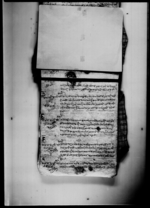A copy of a lālamohara from King Rājendra appointing Lakṣmīnātha as priest of Śrī Ratannātha at Phalabang (VS 1878)
ID: K_0013_0029E
Edited and
translated by Christof Zotter
Created: 2021-10-09;
Last modified: 2022-03-04
For the metadata of the document, click here
The accompanying edition, translation/synopsis and/or commentary are available under the terms of the Creative Commons Attribution-ShareAlike 4.0 International License
Abstract
In the original of which this document is a copy, the king, who according to the date must have been Rājendra, appoints Lakṣmīnātha to perform the regular and occasional worship of Śrī Ratannātha at Phalabang.Diplomatic edition
[1r]
1१०४नं1पो१४पा३५सी१[?]५2भंनौहर्ष
3हेनाराराम1आगेलक्ष्मीनाथकेफलालवाङ्गकाश्रीरतनंनाथकोपुजाहारी•षालीहुंदा
2वुटीनाथकोमोहरहानीवक्सौपरापुर्वकारीतलेनीत्यनैमीत्यपु
3जामारुजुहुनुरहीहाम्रोजये़मनाईपुजामाथानमा [unknown seal] लग्याकोलाई
4सेषरह्याकोआफ्नाषातीरज्मासीतगुठजानीभोग्यगरईतीसम्वत
5१८७८सालअषादसुदी१२रोज५सुभं¯¯ ¯¯¯¯¯¯¯¯¯¯¯¯
Translation
[1r]
[in the left margin:]
Number 1041
Bundle (po[kā]) 14, pā 35, sī 1[?]52
The one who said (bhaṃ for bhaṃne) [was] the clerk (nau for nausindā)Harṣa
The one who watched (he for herne) [was] Nārārāma (?)3
[main text:]
Āge: to Lakṣmīnātha
As [the post of] pūjarī of Śrī Ratannātha (text: Ratana°) of Phalabang (text: Phalā[...]vāṅga) is becoming vacant, we have annulled the mohara of Vuṭīnātha [and] have granted [you the following rights]: As [was] the earlier custom, be present for the regular and occasional worship, celebrate our triumphs, [be] conscious of your duty, conceive the guṭha [as yours, and] enjoy what remains after covering worship and shrine [expenses].
Thursday, the 12th of the bright fortnight of the month of Āṣāḍha, in the [Vikrama] era year 1878 (1821 CE).4 Auspiciousness.5
Commentary
From the available documents it seems that the post of the pūjārī of Śrī Ratannātha at Phalabang was occupied in a rotating system, at least in the time of Lakṣmīnātha. According to an executive order (rukkā) from VS 1869 (see K_0636_0011) the pūjārī of the said shrine was one "Vuṭinātha" (cf. Naraharinātha VS 2022: 449, who spells the name as "Buṭinātha"; see also Commentary in K_0013_0020B). Then, in VS 1873, "Vuṭhīnātha" was replaced by one "Lachīnātha", probably the Lakṣmīnātha of the present document (see K_0013_0020B), and, in VS 1877, the mohara of "Lachinnātha" was annulled and "Vuṭinnātha" (re)appointed (see K_0015_0012B). The arrangement under the present document (re)appointing Lakṣmīnātha lasted for 14 months. In Bhadra VS 1879, it was ordered to annul this mohara and appoint one Pratāpanātha as pūjārī (see K_0014_0009A); according to the Rājaguruyogīvaṃśāvalī of Nārāyaṇanātha published by Yogī Naraharinātha, he was a disciple of Vuṭinātha (Naraharinātha n.d.: 69). Interestingly, this vaṃśāvalī does not mention Lakṣmī- or Lachīnātha among the disciples who stayed at the rājagurupīṭha of "Siddha Ratnanātha" at Phalabang after Siddha Bālakanātha. Thus he probably belonged to another lineage. If he is the "Lakṣmīnātha" mentioned in a document from VS 1873 (K_0013_0020C) as guru of Sādhunātha and Darīpaūnātha, he came from Caughera to Phalabang.

